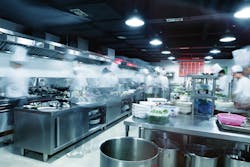Connected Technology: A Boon for Refrigeration Contractors
Visit any recent HVACR industry trade show, and you will see connected technology has been built into virtually all of the products on display. From smart thermostats, to equipment that actively communicates with other HVACR components, the digital age continues to evolve solutions that apply to many industries, including food retail and foodservice.
Why not connect the kitchen equipment into the store’s existing systems? This is a simple solution for operators, and it’s an emerging capability today.
The adoption of new technology has also had a ripple effect in other areas, and no one knows this better than the contractors who install and service HVACR equipment. For years, contractor responsibilities have included many aspects of supermarket or convenience store operations, and retail management has grown to depend on their technicians to keep the equipment up and running in an efficient manner. Contractor business owners, in turn, understand the additional value they can provide through fewer customer site visits, resulting in a happier client and lower costs to deliver their services.
The 'Internet of Things' Age Brings New Opportunities
The 'Internet of Things' (IoT) is a network of physical items — refrigerated cases, ovens, buildings and other systems — embedded with electronics, software, sensors and network connectivity, that enables the collection and exchange of data. Retailers can become more organizationally nimble with the continued use of IoT, because the information and insights they need are readily available. In turn, contractors can use this technology to their advantage to provide better service.
ADVANTAGE #1: Quicker, More Accurate Installations
For HVACR contractors, performing installations correctly the first time around is an excellent way to secure and maintain a relationship with their customer. Using the Internet of Things to deploy connected devices takes this a step further. Many grocery and convenience store facilities currently use building management systems to control HVAC, lighting and refrigeration. So, why not connect the kitchen equipment into the store’s existing systems? This is a simple solution for operators, and it’s an emerging capability today.
Through a connected system, technicians can download a program to a controller or piece of equipment to allow it to be auto-configured.
Connected kitchen equipment — for example a speed oven —can provide data, which can be analyzed for valuable, actionable insights about operating activity and maintenance status. Verification-related insights can confirm whether a recently fitted piece of equipment was installed properly and is operating correctly.
Automated configuration can also save time and money for both the contractor and retailer. Through a connected system, technicians can download a program to a controller or piece of equipment to allow it to be auto-configured. This action saves time on the install and ensures consistent programming of equipment software. It also benefits the contractor who can complete the job quicker and get their customer online faster. Imagine the savings of rolling this activity out for a 500-unit chain.
ADVANTAGE #2: Focus on Customer Satisfaction and Improving the Bottom Line
As food retailers expand their foodservice offerings to increase revenue, the store environment becomes more complex. Equipment management for kitchens becomes even more important as productivity and food quality can directly affect the customer experience, and ultimately impact the bottom line.
Retail store environments will continue to be populated with legacy equipment and new generations of devices functioning on different operating systems. By connecting the equipment through IoT, contractors can remotely upgrade these systems with the latest software. There will be minimal lost time due to taking equipment down or swapping out pieces. Technicians will not have to be onsite to make adjustments, translating to an improved user experience. Embedded electronics also allow the contractor to remotely monitor equipment for quality control, improve on-time production, while also making available programs that might have benefits offline.
Retail store environments will continue to be populated with legacy equipment and new generations of devices functioning on different operating systems. By connecting the equipment through IoT, contractors can remotely upgrade these systems with the latest software.
Using IoT is especially productive for rolling out time consuming regional or national installations. For example, a chain of 1,000 stores spread over 10 geographic regions wants to standardize its setup and configuration to minimize training. Traditionally, a contractor would install the program individually at each location or central management would overnight ship the program on a disk or a flash drive and rely on store staff to manually install the updates. That scenario may take months, and there is no potential for confirmation that the system was installed properly and is operating correctly. With connected equipment, the program can be installed remotely, ensuring consistency and accuracy across the region. This new IoT-enabled process can be done in minutes, allowing the store to be configured and operating productively, sooner.
ADVANTAGE #3: Remote Monitoring & Management Services
Another opportunity brought about by IoT occurs when there is a service issue. A piece of infrastructure may typically signal a problem that can be fixed remotely, but in some instances, a technician needs to be dispatched to inspect the equipment onsite, and then procure the parts to fix it.
With a connected kitchen, remote monitoring alerts operators when equipment is not operating properly. Often, the issue can be triaged before dispatch, providing the contractor with information about the potential problem so they bring the right tools needed to make the repair. These intelligent technologies can also determine whether an issue can be solved during business hours, avoiding time-and-half charges for the customer. With remote monitoring of these connected systems, troubleshooting a maintenance issue falls on qualified individuals, allowing store associates to focus on serving customers.
This can also be a new line of revenue for contractors, if they are open to monitoring equipment for their customers. Emerson Climate Technologies can help them to leverage applications for remote monitoring and troubleshooting now that the equipment is connected.
ADVANTAGE #4: Extended Service Leads to Additional Opportunities
Assuming the retailer is using the equipment according to OEM and contractor recommendations, the likelihood that it will last for many years is high. The contractor and facility manager should know which filters, foodservice equipment components or refrigeration system widgets need to be replaced on a timely basis -- and if the consumable parts are being replaced based on actual use, rather than on a standard schedule.
A connected kitchen allows contractors to verify that the customer has maintained the equipment at the proper intervals and specifications. It also provides an early warning when there are service issues, that when dealt with quickly, don’t escalate into more expensive repairs.
Extended service is similar to the three-year test drive for the automobile industry, in which the car is better cared for, and thus, has a higher resale value. This leads to an opportunity that contractors can offer customers; leasing equipment to corporate management or to franchisees with a renewal strategy. The usual scenario would allow the franchisee to enter into a three-year lease arrangement with a contractor where at the end of the lease the customer has the option to buy or replace the equipment. All maintenance and warranties are covered under the lease. It’s a new approach to provide up-to-date equipment to the customer and a steady stream of income for the contractor.
With an extended service relationship, there may be concerns with the equipment’s residual value due to the always-on usage in a retail environment. But when this equipment is connected, end-users will have access to insights for maintaining the equipment in good operating condition. The connected network provides the ability to complete preventive maintenance remotely, proactively addressing potential issues before they become significant. The contractor can now lease the franchisee not only a new fryer, but also promise 99 percent equipment uptime. The lease allows the contractor to engage in an ongoing relationship with the owner who might need other items and services.
ADVANTAGE #5: Making Insights Actionable
Intelligent, connected technologies are already installed in many grocery and convenience store environments today — at the checkouts, in the back of house and within the foodservice areas. As contractors look for ways to expand their footprint with clients and provide more services, adopting a solid IoT plan helps to not only support client needs with more detailed analytics about what’s really happening at the unit level, but will also further establish contractors as “their guy” for future needs.

